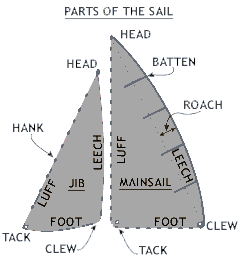Locate the clew of the mainsail. Starting at the point where the boom connects to the mast, insert the clew into the groove of the boom and pull it out to the end while another person feeds the foot of the sail into the groove. A pin is placed through the tack corner, the "outhaul" is attached to the clew, pulled tight to stretch the foot, and "secured" or cleated. 
The battens are then placed in the batten pockets of the sail. Check that you have the right length of batten in the proper pocket. Starting at the tack, follow along the luff to make sure there are no twists in the sail. Attach the main halyard, looking "aloft" (up) in case it's "fouled" (twisted) around a spreader or backstay. If the main luff has slides, put them all on the mast track starting at the head of the sail. If the mast is grooved, you will have to feed the luff of the sail in the groove as it goes up. However, before you hoist the mainsail, it's best to get the jib ready. If the jib is not rolled up on a roller furler, it will have to be attached each time you go out sailing. The tack of the jib is the corner that is attached first. There are a number of ways to quickly identify this corner:
the sailmaker's label or emblem is almost always located there since there is an International Sailing Federation rule to this effect; - the angle at the tack is much wider than the angle at the head;
- the jib hanks, or snaps, usually attach to the jibstay from right to left, for right-handed people—in other words, with the opening in the snap on the left. If you dump a large sail out of the bag, just by looking at one jib hank you can tell which way to follow the luff to the tack;
- a good crew, knowing that the tack is needed first, will leave that corner on top of the sail after "bagging it" (putting it away in a sailbag); and
- on larger boats, "Tack" is often written at the corner so there can be no mistake.
Attach the tack of the jib and start hanking on the snaps from bottom up.If you start at the top of the sail, you would have to hold the sail up and hank on each snap underneath. This would get mighty heavy after a while. Also, the sail would be up high where a gust of wind could blow it overboard. So you start with the tack first and pull the sail forward between your legs to keep it low, protected from the wind, and to avoid draping it over the side of the bow in the water. The jib sheets (the lines that adjust the jib in and out) are now attached to the clew and led through their proper "leads" (blocks, or pulleys, that adjust the trim angle of the jib), and either a "figure-eight" knot or "stop" knot, is made in the end of each sheet. This keeps the end of the line from running out of the jib lead when you let it go. Of the two knots, the "stop" knot is the better. Now attach the jib halyard that will pull the sail up, and you're all set to go. The mainsail is raised first for various reasons. It acts like a weather vane and keeps the boat headed into the wind. This is most important on a cruising boat since you are apt to motor out of a harbor, head the boat into the wind, and idle the engine while the mainsail is raised. If the boat swings broadside to the wind, which might happen if you raise the jib first, the mainsail will fill with wind, press against the rigging, and bind on the sail track, making it virtually impossible to raise the sail farther. The same problems arise on smaller boats, but if you start from a mooring, the boat automatically "lays" with her bow pointed directly into the wind. Sometimes the current is strong enough to overpower the wind's effect, but in that case, usually the wind won't be strong enough to create problems in raising the sail. Therefore, with small boats sailing from moorings, the only reason to raise or unroll the jib last is because it flails around during and after raising. This tangles the jib sheets and causes an awful commotion on a windy day, which continues until the main is raised and you start sailing. The flailing also reduces the life of the jib because it breaks down the cloth fibers and fatigues the sail. If the jib is rolled on the forestay, just release the furling line and pull on the leeward jib sheet to unroll it for use. One important item to remember when raising sails is that all the sheets must be completely loose so the sail will line up rather than fill with wind. At the same time, all lines that might be holding the boom down (like the cunningham or the boom vang) must be eased so that nothing can keep the main from going all the way up. A crew member should hold the end of the boom up in the air to relieve the pull of the leech of the sail if the boat does not have a topping lift (line to hold the boom end up).
| Contents | 1 | 2 | 3 | 4 | 5 | 6 | 7 | 8 | 9 | 10 | 11 | 12 | 13 | 14 | 15 | 16 | 17 | 18 | 19 |
[Previous Chapter] [Next Chapter]
|